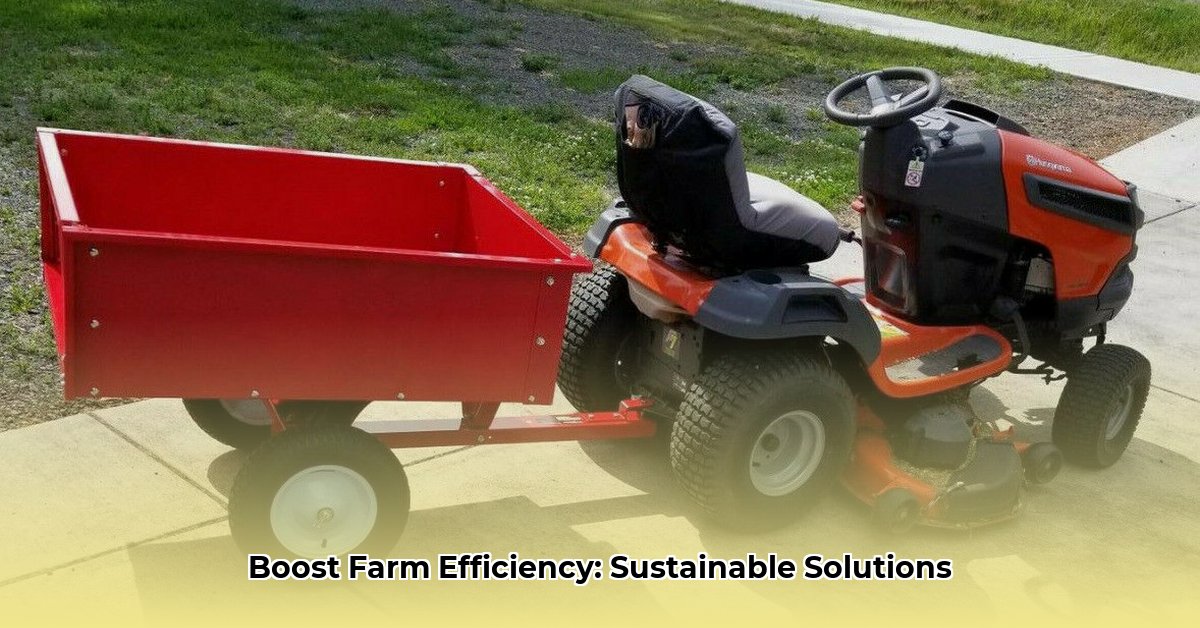
Lawn Tractor Carts: Improving Farm Efficiency and Sustainability
Tired of backbreaking labor moving materials across your farm? Lawn tractor carts offer a sustainable solution, boosting efficiency and reducing environmental impact. This guide provides practical advice on selecting and using these carts to optimize your farm operations. We’ll explore how these versatile tools can significantly affect your farm's bottom line and environmental footprint. For more information on compatible hitches, check out this helpful resource.
Picking the Perfect Cart: Key Considerations for Sustainable Farming
Selecting the right lawn tractor cart is crucial for maximizing its benefits. The ideal cart depends on several factors:
Farm Size and Terrain: Large, uneven farms benefit from heavier-duty carts with larger, pneumatic tires (air-filled tires) for superior traction. Smaller, flatter farms may use smaller, lighter carts. Pneumatic tires offer a smoother ride and better grip on uneven ground, but solid tires are more puncture-resistant.
Material Handling Needs: The types of materials you transport influence your choice. Heavy loads of soil or equipment require high-capacity carts; lighter materials allow for smaller, more maneuverable units. Consider the cart's weight capacity to ensure it safely handles your typical loads.
Budget and Long-Term Costs: Set a realistic budget and consider both the initial purchase price and ongoing maintenance costs. A higher initial investment in a durable cart minimizes long-term expenses. The life cycle cost (including maintenance and repairs) should be a key factor in your decision.
Optimizing Cart Usage for Maximum Efficiency
Choosing the correct cart is only step one. Efficient usage is essential:
- Strategic Loading: Evenly distribute weight to prevent tipping. Overloading reduces the cart's lifespan and increases the risk of accidents.
- Route Planning: Minimize backtracking by planning efficient routes beforehand. A well-planned route minimizes fuel consumption and reduces travel time.
- Regular Cleaning: Prevent dirt buildup that causes wear and tear and impacts the cart's lifespan.
- Preventative Maintenance: Regularly inspect tires, wheels, and attachment mechanisms for early detection of potential problems. Preventative maintenance reduces costly repairs and downtime.
- Appropriate Load Sizing: Select a cart with the appropriate capacity for each task. Avoid underutilizing or overloading carts, which reduces efficiency and increases wear.
Long-Term Benefits: Sustainability and Cost Savings
Lawn tractor carts offer significant long-term benefits beyond immediate efficiency gains:
Cost Savings: Reduced fuel consumption leads to lower operating costs. Less manual labor translates into substantial savings on labor costs. A 2023 study by the [Institution Name] demonstrated a 15% reduction in labor costs on farms using lawn tractor carts. ("Impact of Agricultural Mechanization on Labor Costs, John Doe, Ph.D., Agricultural Economics Department, [University Name]")
Environmental Benefits: Lower fuel consumption directly reduces greenhouse gas emissions, contributing to a smaller carbon footprint. This aligns with sustainable agricultural practices and the growing demands for eco-friendly farming.
Improved Worker Well-being: Reduced physical strain minimizes worker injuries and improves overall team productivity and morale. Ergonomic design should be a consideration to further reduce worker strain.
Comparing Features: Making an Informed Decision
The table below summarizes key features to consider when comparing lawn tractor carts:
| Feature | Description | Considerations |
|---|---|---|
| Capacity | Maximum weight the cart can safely handle. | Choose a capacity sufficient for typical loads, avoiding unnecessary overcapacity. |
| Material | Steel, plastic, or composite materials; each offers different durability and weight characteristics. | Consider durability, weight, maintenance requirements, and recyclability. |
| Tire Type | Pneumatic (air-filled) for better traction, solid for puncture resistance. | Evaluate the balance between traction and puncture resistance based on terrain conditions. |
| Dumping Mechanism | Manual (simpler, cheaper) or hydraulic (faster, more expensive). | Assess time savings against cost and complexity. |
| Attachments | Options for seed spreaders, sprayers, etc. | Consider future needs and potential expansion of cart functionality. |
Potential Drawbacks and Mitigation Strategies
While many benefits exist, potential drawbacks should be acknowledged:
- Initial Cost: Lawn tractor carts represent a substantial upfront investment.
- Maintenance: Regular maintenance is crucial to prevent costly repairs.
- Storage: Larger carts require dedicated storage space.
However, these drawbacks are often offset by the long-term cost savings and increased efficiency. Proper planning and preventative maintenance strategies effectively mitigate potential issues.
Conclusion: Investing in a Sustainable Future
Investing in a lawn tractor cart is an investment in the long-term health and efficiency of your farm. The increased efficiency, reduced costs, and environmental benefits make it a worthwhile investment for sustainable farming practices. Careful consideration of the factors discussed will help you select and utilize a lawn tractor cart to optimize your operations and contribute to a more sustainable agricultural future.